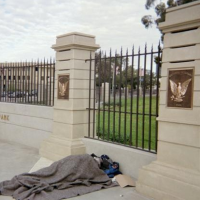State Misses Hundreds of Millions in Federal Aid it Could Use for Veterans
 Veteran sleeping in front of VA campus in Los Angeles (photo: Veterans Today)
Veteran sleeping in front of VA campus in Los Angeles (photo: Veterans Today)
California’s laser focus on the 2,200 military vets in veterans homes to the exclusion of the other 1.8 million veterans living elsewhere in the state has resulted in federal medical and pension benefits worth hundreds of millions of dollars going untapped every year, according to a government watchdog.
The Little Hoover Commission, noting that Texas drew down 30% more in benefits per veteran that California, called for a “new approach to veterans services” in an August report (pdf) to Governor Jerry Brown and the Legislature. Florida drew 16% more than the state.
Around 78.5% of the $385 million California Department of Veterans Affairs (CalVet) operations budget in 2012-13 is earmarked for the state’s six existing veterans homes, and two more that are about to open. Most of the money ($315 million) is from state funds. Another 17% goes to farm and home loans and 2.6% is for services and outreach.
It’s that tiny services division and other lackluster providers where the commission sees a lost opportunity to capture federal dollars. Texas has five times as many state-employed veterans representatives as California helping their constituents track down benefits and assistance. Other state agencies and entities provide services to veterans, including the Department of Health Care Services, the Employment Development Department and higher education institutions, but underachieving CalVet may have the most potential upside.
California also lacks a system for identifying veterans who could be eligible for aid and a lot of the data it does possess is out of date. Women, especially, seem to fall outside the system because of a reluctance to identify themselves as former military.
It doesn’t help that California is home to three regional offices of the U.S. Department of Veterans Affairs (VA) with some of the largest claims backlogs in the nation. It was estimated earlier in the year that those three offices had 79,000 claims pending, with case delays of up to 600 days.
The backlog cases in Los Angeles, San Diego and Oakland alone represent $886 million in untouched benefits. Nationally, the VA estimated that 19,500 veterans died before collecting $437 million in fiscal year 2011-12. The money eventually went to surviving beneficiaries.
The commission noted that the federal process has become more cumbersome for a number of reasons, including survival from battlefield injuries that would have been fatal in the past, and multiple claims in a single filing. Vets are coming back more busted up with fewer personal resources to help them.
The commission report offered a string of recommendations, including a rewrite of the state Military and Veterans Code, which “is confusing, contradictory and misaligned with current CalVet practices and veterans’ needs.” It also recommended better oversight of county veterans’ offices, improved interdepartmental communications and development of a database to track the former soldiers.
But its bottom line was this: pay a few extra dollars to find out who needs assistance and hire people to go get the money from the federal government. There’s lots of it out there and other states are better at getting it than California.
–Ken Broder
To Learn More:
An Agenda for Veterans: The State’s Turn to Serve (Little Hoover Commission) (pdf)
Bonus System to Clear Backlog of Veterans’ Claims Backfires for those most in Need (by Noel Brinkerhoff, AllGov)
Want Your Veterans Disability Benefits? Leave the State (by Ken Broder, AllGov California)
- Top Stories
- Controversies
- Where is the Money Going?
- California and the Nation
- Appointments and Resignations
- Unusual News
- Latest News
- California Forbids U.S. Immigration Agents from Pretending to be Police
- California Lawmakers Urged to Strip “Self-Dealing” Tax Board of Its Duties
- Big Oil’s Grip on California
- Santa Cruz Police See Homeland Security Betrayal in Use of Gang Roundup as Cover for Immigration Raid
- Oil Companies Face Deadline to Stop Polluting California Groundwater





